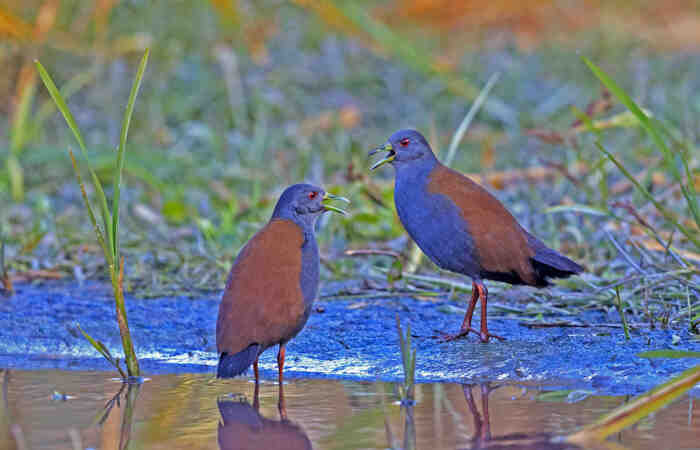Zapornia bicolor
IUCN
LCBasic Information
Scientific classification
- name:Zapornia bicolor
- Scientific Name:Zapornia bicolor,Black-tailed Crake,Amaurornis bicolor,Porzana bicolor,Black-tailed bittern
- Outline:Wading birds
- Family:Gruiformes Railidae Lagomorpha
Vital signs
- length:19.7-25cm
- Weight:72g
- lifetime:About 7-15 years
Feature
A medium-sized frog with a distinct chestnut and almost black coloration.
Distribution and Habitat
Distributed in Bhutan, China, India, Lao People's Democratic Republic, Myanmar, Nepal, Thailand, Vietnam
In China, it is mainly distributed in Tibet, Yunnan, Sichuan and Guizhou provinces. The brown-backed frog is a highland species, living at an altitude of 1000-3600 meters, and can also live in lower areas, 400-2500 meters in Yunnan, China, and below 2500 meters in Tibet, China. It lives in small woods in or around rice fields, small swamps and streams in the forest, banks with tree shade and ponds with grass, usually hiding in dense vegetation and foraging in open areas.
Appearance
The brown-backed frog is a medium-sized frog with obvious chestnut and almost black colors. Male and female of the same color. The head, neck and lower body are dark smoky gray, the top and occiput are darker, and the sides of the head are lighter. The upper body from the forehead to the tail, including the surface of both wings and the inner flight feathers, are all olive color. The upper tail coverts are dotted with white spots, and the flight feathers are dark brown. The chin and throat are white, and the center of the chest and abdomen are dark gray with dark olive-brown horizontal spots. The iris is red; the mouth is greenish, with a red spot at the base of the mouth, which becomes more vivid during the breeding season; the feet and toes are dark red or brick red.
Young birds are similar to adults, but have brown irises instead of blood red.
It is similar to the red-breasted frog, but the brown upper body of this bird contrasts sharply with the dark gray head, neck and under
Details
The brown-backed frog is called Black-tailed Crake in foreign language, and has no subspecies.

The brown-backed frog is a resident bird. It likes to move in streams with vegetation on one side and open grassland on the other side. Its living habits are very similar to those of the red-footed bittern. They often come out to the open grassland in the morning and evening, and come out from their hiding places to forage on the grassland at dawn and dusk. When they encounter danger, they quickly run to the grass or waterside. After reaching the waterside, they either swim or dive in the water, or fly to the other side of the water to hide. Sometimes when threatened, they often lower their heads and tails to run on the ground, or hide in the grass or bushes. Usually they walk slowly and bumpily. The call is a long-drawn descending trill from a hoarse panting sound.
The brown-backed frog is not good at calling, even in the breeding season. It is omnivorous and eats worms, mollusks, insects and seeds of swamp plants, mainly various aquatic insects. When pecking, it moves quickly, with its wings drooping and its tail erect and swinging frequently. It can also forage in open areas near human living areas.
The breeding season of the brown-backed frog is from May to August. It breeds in India from mid-May to the end of August, and in northwestern Thailand in early August. It nests on the ground in grass and bushes on the banks of rice fields and nearby waters, and also on the moist ground around understory bushes in forests not far from waters, or on bushes and trees, 1-2 meters above the ground, up to 7 meters high, and also in small swamps surrounded by rice fields or between rice fields. It is monogamous, and both sexes build nests together. The nest is rough, loosely made of thin branches and weeds. Each nest lays 5-8 eggs, and the male and female take turns to incubate the eggs. The eggs are very similar to those of the red-footed bittern, but the color is brighter. The average egg size is 33.9 mm × 26.1 mm, the largest is 36.3 mm × 25.3 mm and 35.3 mm × 27.0 mm, and the smallest is 31.3 mm × 26.1 mm and 32.3 mm × 25.1 mm. Males and females take turns incubating the eggs.
Industry, water conservancy, fishing, grazing, land reclamation, watering and reed cultivation, and reed cutting have destroyed its habitat. Natural enemies eat its eggs and chicks, such as birds of prey, ravens, weasels, scorpions, wolves, and red foxes. Due to the rarity of the brown-backed frog, criminals hunt it in large numbers for profit. These are the reasons why the brown-backed frog is endangered.
Listed in the IUCN Red List of Threatened Species in 2016 ver 3.1 - Least Concern (LC).
Listed in China's National List of Key Protected Wildlife (February 5, 2021) Level 2.
Protect wildlife and eliminate game.
Maintaining ecological balance is everyone's responsibility!








